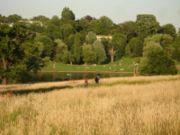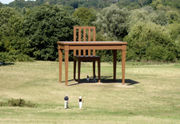Hampstead Heath
2007 Schools Wikipedia Selection. Related subjects: Geography of Great Britain
Hampstead Heath (locally known as "The Heath") is a public open space in the north of London.
The Heath covers 791 acres (320 ha; 3.2 km²). It has 25 main ponds and areas of ancient woodland, bog, hedgerows, and grassland. A part of the Heath has been designated as a Site of Special Scientific Interest by English Nature, the smallest one in London.
Part of the land was originally the common lands of the Manor of Hampstead, while much of the rest was the parkland and farmland of Kenwood House.
It is owned by the Corporation of London, which also maintains most of it. The Kenwood area, 112 acres (50 ha; 0.5 km²), is maintained by English Heritage. Most of the Heath, 681 acres (280 ha; 2.8 km²), lies in the London Borough of Camden. The remaining 110 acres (40 ha; 0.4 km²) is the Hampstead Heath Extension lying in the London Borough of Barnet. The Heath is policed by its own small police force, the Hampstead Heath Constabulary.
Hampstead Heath was featured on the television programme Seven Natural Wonders as one of the wonders of the London area, with a focus on Parliament Hill. The episode was presented by Bill Oddie, who lives nearby and watches birds there regularly.
Public transport near the Heath include National Rail and the London Underground with National Rail stations at Gospel Oak and Hampstead Heath and London Underground "Tube" stations at Hampstead and Belsize Park to the west; Golders Green to the north; Highgate and Archway to the east.
There are no signposts to, or on, Hampstead Heath. Tourist handbooks usually advise visitors to bring a map with them. At the southern tip of the park is the Lido open air swimming pool. Farther north, near the Highgate side, are two ponds in which swimming is allowed, both single-sex (i.e., one is for males only, while the other one is for females only). To the west of these is the 'mixed pond', where members of either sex (male or female) may swim. These ponds are fed by the Fleet River, which starts on the Heath and flows down to the River Thames at Blackfriars. Other ponds are variously used for fishing, model boats, and reserved for wildlife.
Part of the area (the West Heath) has long been well-known for its use by gay men as a cruising ground at night. There have been incidental attacks carried out on people cruising, and indecency prosecutions, perhaps the most famous being R v Thompson (1918), 13 Cr App R 80, known to law students throughout the common law world for its description of the accused "carrying powder puffs" deemed sufficiently inculpating to be admissible in evidence under the similar facts rule. Adjoining the West Heath, not part of Hampstead Heath proper but still run by the Corporation of London, is Golders Hill Park.
In 2005, Giancarlo Neri's sculpture The Writer, a 9 metre tall table and chair, was exhibited on Hampstead Heath. John Atkinson Grimshaw, Victorian era painter, painted an elaborate nighttime scene of Hampstead Hill in oils. Hampstead Heath also provided the backdrop for the opening scene in Victorian writer Wilkie Collins' novel The Woman in White.
Parliament Hill, one of the highest points in London, offers great views over the city.
From 1808 to 1814 Hampstead Heath hosted a station in the shutter telegraph chain which connected the Admiralty in London to its naval ships in the port of Great Yarmouth.
Whilst living in London Karl Marx and his family would take regular Sunday picnics on the heath.



